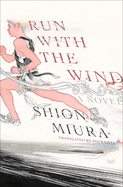
| Publisher: | HarperVia | |
| Genre: | Psychological, Friendship, World Literature, Japan, Coming of Age, Fiction, Sports | |
| ISBN: | 9780063330894 | |
| Pub Date: | October 2024 | |
| Price: | $30 |
| Starred | Fiction |
by Shion Miura, trans. by Yui Kajita
For a novel focused on the importance of running swiftly, Shion Miura's Run with the Wind is a leisurely--and deeply compassionate--narrative about gaining self-trust while solidifying lasting bonds. The book opens with a detailed drawing (by Akira Yamaguchi) facing the prologue page, titled "an illustration of Chikusei-so," a dilapidated college dorm at Kansei University. The exploded view of the two-story structure reveals occupied rooms displayed with the residents' names. As the story begins, though, the house is still waiting for its last and 10th inhabitant--and 10 is exactly the minimum number of members necessary to build a team eligible to enter the Hakone Ekiden, Japan's famed university relay marathon.
Kakeru isn't "just running, but running away." He's stolen a pastry (mahjong ate all his funds); even after outstripping the salesclerk, he's chased by Kiyose, pedaling hard on a bike. Kiyose presents a proposition: move into Chikusei-so, save money, and gain a running community with a purpose. In high school, Kakeru let his brash anger derail a promising track career; saying "yes" could be a chance at redemption. Chikusei-so's (mostly) amateurs might be underdogs, but together, they've got the opportunity to master some of life's best lessons--about hope, respect, strength, and worthy relationships.
Originally published in Japan in 2006 and since adapted for manga, anime, stage, and live-action film, Run with the Wind arrives Stateside deftly translated by literary scholar Yui Kajita, making her full-length translation debut. In any language, Miura is an easy writer to love--encouraging tenacity and championing kindness while imparting a most inspiring story. Team Miura for the win indeed! --Terry Hong
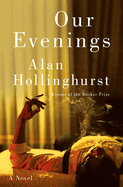
| Publisher: | Random House | |
| Genre: | General, Literary, Fiction, Historical, Gay, LGBTQ+ | |
| ISBN: | 9780593243060 | |
| Pub Date: | October 2024 | |
| Price: | $30 |
| Fiction |
by Alan Hollinghurst
Fans of the great author Alan Hollinghurst (The Stranger's Child) will be delighted by Our Evenings, an elegant, episodic novel that spans half a century in the life of a gay, biracial British stage actor. The actor is David Win, the only child of a single mother. His father, whom David didn't know, was a Burmese man his mother met while working as a typist after World War II. At the start of the novel, David is in bed with his husband, Richard, when he learns upsetting news: Mark Hadlow, a wealthy businessman who, in the early 1960s, sponsored a scholarship for David to attend the elite Bampton school, has died at 94. That scholarship paved David's way to Oxford. It also introduced him to Mark's son, Giles, who would grow up to become a pro-Brexit right-winger, "one of our leading Eurosceptics."
Their lives intersect thereafter while also diverging wildly, with David becoming an actor of moderate renown. He remains close to his mother, a dressmaker, who enters into a business relationship, and more, with a divorcée named Esme Croft. The bulk of this graceful work dramatizes the peaks and valleys of David's life, including career successes and setbacks and his romantic partners--relations that, for a gay, dark-skinned man in Britain, raise more than a few eyebrows. The influence of Henry James on Hollinghurst's work is as pronounced as ever; he even winkingly slips in a Jamesian "hang fire." The edgy refinement of all of Hollinghurst's work is very much in evidence in this excellent book. --Michael Magras, freelance book reviewer
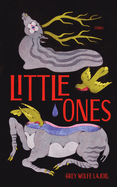
| Publisher: | Hub City Press | |
| Genre: | Dark Humor, Short Stories (single author), Small Town & Rural, Humorous, Fairy Tales, Folk Tales, Legends & Mythology, Southern, Fiction | |
| ISBN: | 9798885740395 | |
| Pub Date: | October 2024 | |
| Price: | $17.95 |
| Fiction |
by Grey Wolfe LaJoie
O. Henry Prize-winning writer Grey Wolfe LaJoie's debut collection, Little Ones, offers 21 bite-size works of fiction that find emotionally piercing stories in unexpected places. While each piece is ostensibly a short story, they reflect as wide a range of genres as they do characters, embracing such forms as the bureaucratic questionnaire in "Questions" and the Wikipedia entry in "Wiki." "Unfished, Unfinished," about an illustrator trying to illustrate, is a clever and psychedelic graphic take on the ars poetica. Meanwhile, even more "traditional" entries like "Ampersand Jansen" and "Interview with the Pope" demonstrate LaJoie's versatility through illustrations in a spectrum of artistic styles that complement their narrative tones.
While LaJoie's ability to slip into different formats and genres is part of what makes this collection refreshing, it's really their willingness to portray such a variety of points of view that make the stories themselves so memorable. "Mention of Flesh" might recount a nameless narrator's struggles to connect with their six-year-old daughter during difficult times, but "Frank" isn't afraid to take on the voice of a chorus of the dead recalling the experiences of a "road-killed raccoon." This range is emphasized by what sometimes feel like purposeful juxtapositions between stories, as with "Interview with the Pope" and the sloppily handwritten "Interview with Horsie," which, while necessarily funny, is also surprisingly heartrending. The ability for LaJoie's work to surprise readers with their emotional heft is never more the case than in "Delivery," in which a wandering dog brings out the best in the people it traverses between. Even among their humor, these stories touch tender spots as they explore underappreciated perspectives. --Alice Martin, freelance writer and editor
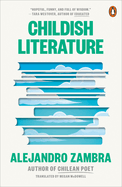
| Publisher: | Penguin Books | |
| Genre: | Family Life, Humorous, General, Fiction | |
| ISBN: | 9780143138082 | |
| Pub Date: | October 2024 | |
| Price: | $18 |
| Fiction |
by Alejandro Zambra, trans. by Megan McDowell
As familial relationships go, the one between fathers and sons has received inordinate attention throughout literature. Alejandro Zambra (Multiple Choice), a Chilean author based in Mexico, considers this dynamic in Childish Literature, translated from the Spanish by Megan McDowell. This excellent book collects essays, two stories, and a poem about father-son bonds. The essays focus on Zambra's relationships with his own father and with his young son. As Zambra writes, the term "children's literature" is condescending and redundant "because all literature, at its core, is childish," an observation meant as a compliment. He demonstrates that point in these pieces, starting with the titular work, a series of vignettes about his son's first year, when the baby is "relentlessly new."
Most of these pieces explore the joys and frustrations of that bond, all of it related in endearingly poetic prose. "French for Beginners" focuses on the boy's desire to read a French-language book about a mole. In "Screen Time," Zambra recalls how he and his wife surrendered to parental exhaustion and "lowered their standards and became habitual viewers of extremely mediocre series." "Blue-Eyed Muggers" tells parallel tales, one about Zambra's son's weekly phone calls with his grandfather and the other about the time 14-year-old Zambra rescued his father from robbers. And among the collection's two stories is "The Kid with No Dad," which portrays a friendship between two boys in Chile, one of whom does not know his father. Themes of memory, forgetting, and, most notably, the value of comfort permeate these exceptional works. --Michael Magras, freelance book reviewer
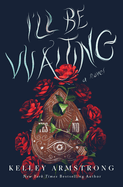
| Publisher: | St. Martin's Press | |
| Genre: | Horror, Ghost, General, Fiction | |
| ISBN: | 9781250284211 | |
| Pub Date: | October 2024 | |
| Price: | $29 |
| Mystery & Thriller |
by Kelley Armstrong
A séance goes horribly wrong when a grieving widow summons more than just her husband's spirit in I'll Be Waiting, a chilling horror novel from Kelley Armstrong. Armstrong (Disturbing the Dead; A Stranger in Town) is as versatile as she is prolific and uses her talent for developing pulse-pounding plots, immersive scenes, and compelling characters to craft a story that will make readers keep a light on.
Nicola Laughton defied the odds, surviving cystic fibrosis well into adulthood and finding her true love. Then a car crash takes Anton from her. Desperate to speak with him one last time, Nicola visits medium after medium, accomplishing nothing more than scaring her family. They agree to a final attempt: a séance with Dr. Cirillo, a parapsychologist and professor who will act as a medium. Together with Jin, Nicola's brother-in-law, and Shania, a friend from grief counseling, Nicola and the professor journey to the lake house where Nicola and her husband used to vacation.
The night the group arrives, a swarm of insects surrounds the house, effectively trapping them indoors. The longer Nicola and her companions are in the house, the harder it is to explain away the mysterious sounds, accidents, and connections to a horrible night more than two decades ago. What is Dr. Cirillo working on when no one is around? Whom can Nicola trust? And what are the sounds in the basement?
I'll Be Waiting is an excellent supernatural horror novel with a strong gothic feel. For anyone who loves staying up late with friends and a Ouija board, I'll Be Waiting is a terrifying treat. --Suzanne Krohn, librarian and freelance reviewer
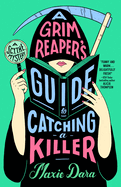
| Publisher: | Berkley | |
| Genre: | Humorous, Mystery & Detective, Fantasy, Cozy - Paranormal, Fiction | |
| ISBN: | 9780593815793 | |
| Pub Date: | October 2024 | |
| Price: | $19 |
| Mystery & Thriller |
by Maxie Dara
While the traditional idea of a grim reaper doesn't bring the words "cozy" and "heartwarming" to mind, those are precisely the vibes Maxie Dara achieves with her debut novel. In A Grim Reaper's Guide to Catching a Killer, Kathy Valence wears sensible clothes and eats in the lunchroom as part of her daily work routine--it's just that her employer is S.C.Y.T.H.E. (Secure Collection, Yielding, and Transportation of Human Essences), and her job is transporting souls of the recently departed to a processing facility so they can move on to whatever afterlife awaits them.
Kathy is pregnant, mid-divorce, and very attached to her routine. Because she believes that she ruins everything she touches, it's important to her that her work remains uninteresting and ordinary. But that goes out the window when a routine collection gets disrupted by the undeniable absence of the soul itself and her subsequent discovery that this isn't a routine collection at all: the soul in question, Conner Ortiz, claims to have been murdered by a S.C.Y.T.H.E. employee. With only 45 days before Connor is doomed to become a ghost that will be trapped on Earth forever, Kathy is forced to rely on her mentor, Jo, and her maybe-ex-husband, Simon, to figure out what went wrong and what's really going on within S.C.Y.T.H.E.
Brimming with tense hijinks and sparkling humor, Dara's novel is an endearing, fun read about what it looks like to challenge damaging mental narratives that can hold one back from building a life of happiness and accepting--and reciprocating--love. --Kristen Coates, editor and freelance reviewer

| Publisher: | Tor Nightfire | |
| Genre: | Horror, General, Apocalyptic & Post-Apocalyptic, Fiction, Science Fiction | |
| ISBN: | 9781250857927 | |
| Pub Date: | October 2024 | |
| Price: | $27.99 |
| Starred | Science Fiction & Fantasy |
by CJ Leede
American Rapture, an adrenaline rush of a novel by award-winning horror writer CJ Leede (Maeve Fly), finds the Midwest ravaged by a strange new virus that infects people with insatiable--and fatal--lust. Sixteen-year-old Sophie has spent her entire life in a sheltered Catholic home. When the infection hits and her parents are among its early victims, Sophie is thrown into a hellish nightmare as she tries to reunite with her twin brother amid the chaos. But the more people she meets and the more she sees of a society that no longer conceals its animalistic impulses, the more Sophie wonders whether sexual desire is a curse or a vital part of life, too long denied.
Leede's blood-soaked, cross-country road trip is not for the faint of heart. Among all the ravenous "biting and licking and pulling and chewing" of the virus's victims are enough jump scares and gore to fulfill every horror fan's dreams. Although Leede never sacrifices an effective chase or thrilling fight sequence, she nevertheless seamlessly slips thought-provoking themes in alongside the novel's high-octane propulsion. Sophie's discovery of the world unfolds gradually, even as that world is exploding around her. The complex desires she fosters for multiple characters grapple convincingly with the sticky web of human sexuality. By the end of American Rapture, the seduction of its many pulse-pounding moments of intimacy is enough to tempt readers into considering themselves as infected as its characters. --Alice Martin, freelance writer and editor
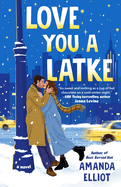
| Publisher: | Berkley | |
| Genre: | Romantic Comedy, Holiday, Romance, Fiction | |
| ISBN: | 9780593815830 | |
| Pub Date: | October 2024 | |
| Price: | $19 |
| Romance |
by Amanda Elliot
Amanda Elliot celebrates the winter holiday season with Love You a Latke, a heartwarming exploration of community and human connection set during Hanukkah.
When coffee shop owner Abby Cohen is steamrolled into organizing a Hanukkah festival in her small Vermont town, she has no idea where to start. Needing inspiration, she searches a dating app for other Jewish people in her area and discovers only Seth Abrams, the handsome but annoyingly optimistic customer who visits her shop every morning. Seth agrees to help, but in return, he asks Abby to pretend to be his girlfriend and spend Hanukkah at his parents' home in New York City. Abby, who grew up in the city but fled her childhood home and emotionally abusive parents several years ago, dreads the thought of returning but reluctantly agrees.
As she is immersed in activities with Seth's parents and friends, Abby is reminded how much she loves the holiday's traditions and misses being a part of a Jewish community. Additionally, their forced proximity compels Abby and Seth to confront their mutual attraction and individual insecurities. They both have habitually avoided confrontations by running away, but perhaps they can move beyond their chosen coping methods and build a future together.
This wonderful novel has a well-defined plot and characters with absorbing emotional depth. The story is set against the contrasting but equally vivid backdrops of New York City dressed in its holiday finery and charming small-town Vermont with its snowy landscape. Elliot's mouthwatering descriptions of latkes, doughnuts, and artisanal coffee will delight readers, as will the rest of her engaging novel. --Lois Faye Dyer, writer and reviewer
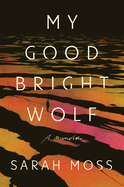
| Publisher: | Farrar, Straus and Giroux | |
| Genre: | Biography & Autobiography, Women, Eating Disorders, Psychology, Psychopathology, Memoirs | |
| ISBN: | 9780374614638 | |
| Pub Date: | October 2024 | |
| Price: | $28 |
| Starred | Biography & Memoir |
by Sarah Moss
Sarah Moss's rigorous, innovative memoir, My Good Bright Wolf, is about creating safety for a body embattled by disordered eating and competing voices.
As a novelist, Moss (Ghost Wall) exhibits compassionate attention and perspective--skills she applies autobiographically here. Her second- and third-person narration emphasizes the contrast between her thinking self and troublesome flesh. Growing up with an angry father (whom Moss calls "the Owl") and judgmental mother ("the Jumbly Girl") who praised her for losing weight, Moss knew she must stay small and never be high-strung. She adhered to an ever-stricter diet, yet her appetite for books remained voracious. Moss casts a critical eye over the literature of her childhood, which preached self-denial, encouraged independent exploration, and often depicted food in problematic ways. After eight years with anorexia, though, it seemed reading might prove Moss's salvation: Naomi Wolf's The Beauty Myth galvanized her to "change the world rather than your body."
However, the memoir constantly questions such easy conclusions. It bears privilege in mind, interrogates memories of abuse via an imagined critic ("If you believe this rubbish you're crazy and if you don't you're a liar"), and undermines rosy recovery narratives: a relapse landed Moss in the emergency room in midlife. Still, she is steadfast in the face of setbacks. The fairy tale wolf, stripped of its menace, is her familiar, a comforting messenger to her younger self. Feisty and original, this feminist text exhorts self and readers alike to "befriend your body." --Rebecca Foster, freelance reviewer, proofreader and blogger at Bookish Beck
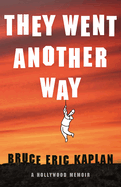
| Publisher: | Holt | |
| Genre: | Biography & Autobiography, Television, Celebrity & Popular Culture, Screenwriting, Topic, Memoirs, Performing Arts, Humor | |
| ISBN: | 9781250370334 | |
| Pub Date: | October 2024 | |
| Price: | $28.99 |
| Biography & Memoir |
by Bruce Eric Kaplan
For six months in 2022, Bruce Eric Kaplan (I Was a Child) was trying to bring his idea for a television show to fruition, but he kept getting the runaround, so he ended up doing a lot of nothing. Using a journal format, Kaplan lays out what happened--and what didn't--carefully, fretfully, and hilariously in They Went Another Way: A Hollywood Memoir.
With Glenn Close and Pete Davidson on board as the leads in Kaplan's intended show, he and his people started shopping the idea. Meetings--with his team, with studio honchos--were scheduled and then, as often as not, pushed back or canceled. In these pages, Kaplan reports on progress and setbacks, and because he has so much downtime while in waiting mode, he intersperses childhood memories, current events bulletins, home-repair updates, and news of the dead animals he keeps finding on his Los Angeles, Calif., property.
Kaplan, who is best known for his New Yorker cartoons, writes with the candor of one of his put-upon characters. In fact, many of his blunt, woeful sentences would work perfectly well as captions ("Is there any way my life could be turned into a musical about nothing ever happening and nothing ever getting fixed?"). His observational humor may conjure Seinfeld--no surprise, as Kaplan wrote for that show's final season--but he also evinces a devotion to his family that turns They Went Another Way into something more than a book about nothing. And yes, it would make a good television show. --Nell Beram, author and freelance writer

| Publisher: | Hachette Go | |
| Genre: | Biography & Autobiography, Discrimination, People with Disabilities, Psychology, Social Science, Interpersonal Relations | |
| ISBN: | 9780306833663 | |
| Pub Date: | October 2024 | |
| Price: | $30 |
| Social Science |
by Tiffany Yu
The Anti-Ableist Manifesto by Tiffany Yu gives readers a list of 33 ways to be actively anti-ableist, including "diversify your feed," "use your privilege," "hire us," and "nothing about us without us." Yu provides readers with the information they need to challenge the status quo and become better allies to the disabled community.
Yu, the founder and CEO of Diversability, a virtual disability-centered employee resource group, discusses simple actions, such as how to stop using ableist language, and more complex efforts, such as getting involved in local politics by attending community meetings and encouraging leaders to include disabled voices.
The book contains one chapter for each item in the manifesto, and Yu consults people with many kinds of disabilities for insight about what needs to be done and how, noting that disabled people are not a monolith. She includes statistics that strengthen her arguments. For example, there are 1.85 billion disabled people in the world, and "the disability market controls $13 trillion in disposable income." Why, Yu asks, wouldn't businesses want to cater to such a large group?
Each chapter ends with action items and reflection questions, giving readers space to absorb what they've just read. Interwoven through the book is the idea of universal design, the concept that a design that makes life easier for disabled people is likely to make life easier for everybody. Accessibility innovations such as curb cuts, electric toothbrushes, and automatic doors benefit nondisabled people, too.
Reflective, informative, and engaging, The Anti-Ableist Manifesto is an excellent choice for readers wanting to be better members of their community. --Alyssa Parssinen, freelance reviewer and former bookseller
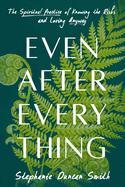
| Publisher: | Convergent | |
| Genre: | Biography & Autobiography, Self-Help, Christian Living, Women's Interests, Personal Memoirs, Religion, Memoirs, Motivational & Inspirational | |
| ISBN: | 9780593727751 | |
| Pub Date: | October 2024 | |
| Price: | $26 |
| Starred | Religion |
by Stephanie Duncan Smith
Stephanie Duncan Smith's poignant, powerful debut memoir, Even After Everything, draws insightful parallels between the Christian liturgical year and Duncan Smith's own journey of pregnancy loss, new motherhood, and stubborn hope. As she navigates "hope in the after, hope against the grain of entirely reasonable fear," Duncan Smith explores the highs and lows of the Christian narrative, set into a calendar pattern that repeats every year, and invites believers to walk with her deeper into the story.
Recounting her path toward parenthood, Duncan Smith recalls the tender excitement of her first pregnancy and the sharp devastation of its end, which happened at Christmastime. She traces the terror and anticipation of carrying another child to term during a global pandemic and offers reflections on the life of Christ detailed in the church calendar and the "divine solidarity" of the Incarnation. For Duncan Smith, and for millions of believers over the centuries, the true miracle of faith is this "radical act of empathy embodied," which allows the divine to share in the deepest human experiences.
Duncan Smith writes honestly about the jarring moments when personal griefs scrape against moments of societal celebration, when "so much happens and so little makes sense." She looks grief in the face, but she also makes room for joy: her daughter's first laugh, the smell of strong coffee, the ancient and enduring powers of hope and love.
Full of beautiful questions, contemplations of living with uncertainty, and the raw courage it takes to move forward, Even After Everything offers wisdom and companionship to anyone who has taken the great risk of love after loss. --Katie Noah Gibson, blogger at Cakes, Tea and Dreams

| Publisher: | Tundra Books | |
| Genre: | Animals, United States, Music, Marine Life, Biographical, Juvenile Fiction, Performing Arts | |
| ISBN: | 9781774883945 | |
| Pub Date: | September 2024 | |
| Price: | $18.99 |
| Starred | Children's & Young Adult |
by Zachariah OHora
Zachariah OHora's picture books Stop Snoring, Bernard! and No Fits, Nilson! center on animals and silliness. Whalesong: The True Story of the Musician Who Talked to Orcas centers on animals, minus the silliness, although OHora cushions his serious message with merriment in this true tale of compassion, animal rights, and the power of music.
In 1971, flutist Paul Horn and his two young sons liked to visit the two orcas at the aquarium near their home on British Columbia's Victoria Island. On one visit they encountered Dr. Paul Spong, who was playing recorded classical music in an effort to communicate with the whales. The next day, Paul Horn played his flute for the orcas, who seemed to move with the music; some days later, they were singing along ("Eeeeeeettttttsssshhhhhh!"). After one of the orcas died, the other was despondent until Paul's flute playing seemed to revive its spirits. The book's final spread declares that the two Pauls "helped people see how much orcas suffer in captivity" and that whales should be studied in the ocean, "where they belong."
Whalesong is written with a bubbly buoyancy (regarding Paul Horn's surname: "It's sort of funny that he prefers to play the flute!") and a hippie vibe that matches the book's early-1970s setting. OHora's digitally fine-tuned pencil-sketch art abounds with vibrant greens and sunflower yellow, and when bearded, tunic-wearing Paul and his kids aren't sitting cross-legged on the ground, they're dancing as if no one is watching. As conservation books for kids go, Whalesong may be the grooviest. --Nell Beram, freelance writer and YA author
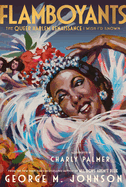
| Publisher: | Farrar, Straus and Giroux | |
| Genre: | Biography & Autobiography, Young Adult Nonfiction, United States - 20th Century, History, LGBTQ+, Cultural & Regional | |
| ISBN: | 9780374391249 | |
| Pub Date: | September 2024 | |
| Price: | $18.99 |
| Starred | Children's & Young Adult |
by George M. Johnson, illust. by Charly Palmer
"Blackness is inherently queer," writes George M. Johnson (We Are Not Broken; All Boys Aren't Blue) in Flamboyants: The Queer Harlem Renaissance I Wish I'd Known, a triumphant and deeply personal illustrated essay collection that pays homage to 12 LGBTQ+ Black artists and the resounding impact they've made on future generations.
In refreshingly approachable language, Johnson highlights individuals from the prolific 1920s arts movement--including Langston Hughes, Zora Neale Hurston, and Ma Rainey--noting that many weren't public about their sexuality but expressed it through their art, "leaving us a road map for the future." The author's unapologetic perspective includes critiques, such as a discussion of Josephine Baker's apparent internalized homophobia, saying that "Fame doesn't always allow you to be who you are" and "it's okay to talk about people in their totality." Johnson emphasizes parts of the subjects' queer identities that were previously hidden, "suppressed or told inaccurately" and includes personal pieces, recounting feelings of rejection and confusion due to a lack of access to Black queer peoples' stories as a youth.
Each person from the queer Harlem Renaissance is captured in a stunning, brilliantly colored double-page illustration by Charly Palmer (The New Brownies' Book). Palmer's telltale bold brushstrokes and vivid hues depict the artists in close-up, with meaningful collaged items surrounding them. The images, much like the queer icons they depict, beg to be studied and proudly displayed. Flamboyants, through Johnson's dedicated research and devotion to their subjects, successfully demonstrates how "what was once done in silence and in the dark has moved toward the light." --Kieran Slattery, freelance reviewer, teacher, co-creator of Gender Inclusive Classrooms
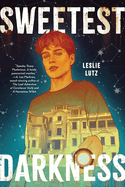
| Publisher: | Holiday House | |
| Genre: | Paranormal, Occult & Supernatural, Horror, Thrillers & Suspense, Young Adult Fiction, Supernatural | |
| ISBN: | 9780823454945 | |
| Pub Date: | September 2024 | |
| Price: | $18.99 |
| Children's & Young Adult |
by Leslie Lutz
A teen clairvoyant accidentally unlocks a great evil and must stop it before it swallows everything he knows in this propulsive and unsettling YA horror novel set in a small Texas town.
Seventeen-year-old Quinn O'Brien is more than spooked when his older brother, Ollie, brings home a safe from the Alvarado, Gypsum's haunted hotel. Quinn, who has the ability to enter "the Dark Place," an intangible, veiled world where "bits of the future jumble through his mind," has repeatedly had a shared nightmare with his friends June and Selena about the hotel. Selling the antique safe is Ollie's latest "sure thing" to get the pair caught up on the mortgage that he is responsible for since their Gram died and left him the house. But strange visions instead compel Quinn to unlock it, and a man named Kit steps out, thanks Quinn, and walks away. In the days that follow, people go missing and constellations disappear from the sky. Quinn knows he must re-trap Kit--but he also knows that Kit can and will get into his head to stop him.
Sweetest Darkness by Leslie Lutz (Fractured Tide) is eerie and twisted. A magical atmosphere overlays the gorgeous rolling desert landscape where Quinn has grown up, his "first baby blanket" the Milky Way. Fleshing out the town's creepy vibe and Quinn's power are journal entries from the young adults' great-grandfathers recalling strange events, cursed film sets, and in-fighting. Lutz writes well-developed characters, especially Ollie, a deeply loving older brother trying hard to understand Quinn's burden. Quips nestle alongside tragic moments and frightening images, like gnashing, invisible teeth. This novel is at once disturbing and joyous. --Samantha Zaboski, freelance editor and reviewer
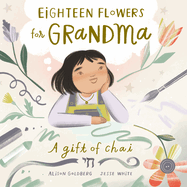
| Publisher: | Red Comet Press | |
| Genre: | Religious, Holidays & Celebrations, Other, Religious, Family, Juvenile Fiction, Multigenerational, Jewish | |
| ISBN: | 9781636551210 | |
| Pub Date: | September 2024 | |
| Price: | $19.99 |
| Children's & Young Adult |
by Alison Goldberg, illust. by Jesse White
Alison Goldberg (Bottle Tops) and Jesse White (Mabel Meets a Black Bear) have achieved a picture-book trifecta: Eighteen Flowers for Grandma is a stirring ode to intergenerational family bonds, a gentle introduction to a Jewish custom, and an up-close look at the artistic process.
It's "art day with Grandma" for Sadie: they work side by side at their easels in pursuit of what Grandma calls "creative inspiration." But for Grandma, art making is no leisure activity: today's painting is her last assignment before she graduates from college the following week. It's an occasion for which Sadie wants to give her "a special gift of chai"--the word means "life" in Hebrew--like the necklace that says "chai" that Grandma gave her when she graduated from kindergarten. Sadie's search for the perfect gift leads her to experiment artistically with a lilac blossom, "but there is something about this painting that just isn't Grandma enough." Will Sadie find creative inspiration in time for Grandma's graduation?
Sadie's art-making process ("She dips and prints, dips and prints," and so on) is captured both in the text and in White's elegant illustrations, which prioritize lilac, chartreuse, and vegetal greens and, per the book's back matter, incorporate the artist's "own take" on Jewish paper-cutting, a "traditional form of Jewish folk art... made by cutting figures and sentences from paper or parchment." It all adds up to a soothingly nutritive reading experience. Too bad Sadie can't give Grandma Eighteen Flowers for Grandma, a fine choice for anyone looking to give the gift of chai. --Nell Beram, freelance writer and YA author